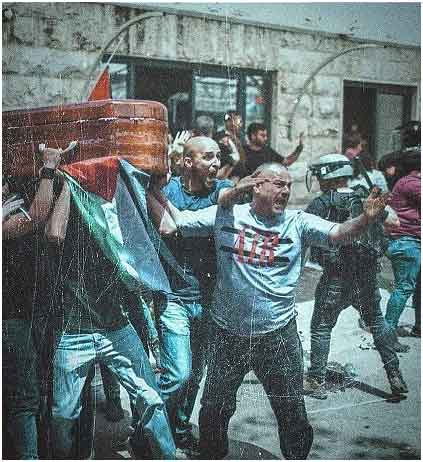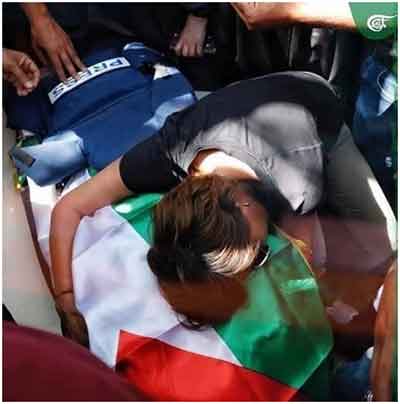Where is the Rabbi? Shireen Abu Akleh’s Via Dolorosa

Israeli police attack mourners at funeral for slain journalist Shireen Abu Akleh. Image is a capture from a video clip circulating on social media (https://fb.watch/c_28BmgFX9/).
Of the hundreds of thousands of images flowing in quick succession on social media in the aftermath of Shireen Abu Akleh’s extrajudicial execution undertaken by a State actor, namely Israel, three in particular will never leave me.
I’ll start with the most surrealist of the three, the one that made me want to poke someone in the ribs and shout, “Wait, go back; did you see that?” It comes from the tail end of a video clip on Facebook showing the attack of Israeli police on Palestinian pallbearers/mourners carrying her coffin draped in the Palestinian flag. The incident took place during the last leg of a devastatingly emotional funeral procession that had begun in Jenin the day before and ended in Jerusalem/Al-Quds. For coverage of this yet another nationally cataclysmic event in the history of Israel’s occupation of the West Bank and Gaza, go to Al Jazeera.
Following is a video clip of the attack circulating on social media (“The World must see…” – The Palestinian Information Center):
At the end of the clip, you will see a Palestinian mourner holding up a funeral wreath and walking between the line of Israeli police and the staggering pall-bearers. To me, the action brought to mind images from sci-fi movies of someone warding off a blood-sucking vampire by holding up a crucifix in the vampire’s face. But to other people, this shocking incident took on religious undertones. It is being dubbed Via Dolorosa in reference to the processional route in the Old City of Jerusalem/Al-Quds, where Jesus is said to have walked on his way to crucifixion as he was being flogged by Roman soldiers.
The images are already seared into our collective memories in the same way that the video clips and still images of JFK’s assassination and funeral procession are seared into the collective memory of Americans. The religious references that Palestinians have reached for in this instance are apt, not only because of the location where the sorry spectacle took place, but also because of the ongoing violent judaization of Jerusalem/Al-Quds (and, indeed, the rest of the West Bank) that continues to outrage both Muslim and Christian Palestinians alike. This brings me to the second image I would like to discuss, the one of the Patriarch and Mufti of Al-Quds, mourning side-by-side:

The Patriarch and the Mufti at Shireen Abu Akleh’s funeral in Jerusalem/AlQuds (image circulating on social media with no attribution)
When I posted the above image on Facebook, I headlined it (as I am titling this piece) “Where is the rabbi?” It’s a logical question to ask in a city that is of such significance to all three interrelated monotheistic religions in the Middle East. In pre-Zionist times, the very small number of religious Jews in Palestine, all of them Sephardic and Arabic speakers, lived peacefully alongside native Palestinians, and it is easy to imagine a rabbi then mourning alongside the Patriarch and the Mufti. But such people no longer exist today in this Jewish state.
As owned by Zionism, “Jewishness” manifested itself at the funeral of Shireen Abu Akleh in the form of fascist soldiers operating within a brutal Jewish supremacist apartheid state founded on Palestinian dispossession and ethnic cleansing. A few days before the commemoration of the 74th anniversary of the Palestinian Nakba, the barbaric savagery of the Zionist regime is on show for all the world to see. As Steve Salaita succinctly put it: Why attack mourners? “Because they weren’t also in the casket.” Such bloody-mindedness applies to the Chief Rabbis of Israel as well as to conscripted soldiers.
A rabbi mourning alongside the priest and the sheikh would have elicited the same reaction as that expressed on Twitter by Mohamad Bazzi in reaction to the Saudi Foreign Ministry extending condolences to the family of Jamal Khashoggi: “There’s a fitting Arabic proverb [to apply here]: He kills the victim, and walks in his funeral.”
The third image that will never leave me is, unfortunately, a very familiar trope for Palestinians. By that I mean the image of a woman, usually a mother, distraught with grief, prostrate over the body of a martyred son.

A tender embrace of Shireen Abu Akleh’s casket by a mourner (circulating on social media with no attribution)
Shireen’s parents are both deceased. She was deeply mourned by her brother and an entire nation, because, like Princess Diana, whom everyone felt they knew, Shireen had entered our living rooms and our hearts and we felt connected to her. “It has to be said that Shireen has broken the Internet today and broken hearts around the world,” said Lyse Doucet, Canadian BBC Presenter and Chief International Correspondent.
She was our voice in a medium that largely mutes it, that even when exposing Israel’s crimes, as Orly Halpern does for Time Magazine from Jerusalem, journalists unquestioningly accept the assumption that Palestinian armed resistance is terrorism, whereas Israel’s state terror is simply “a mistake;” something that should be condemned, true, but is fixable, because Israel can be “Jewish and democratic;” it just has to try harder. So, Halpern writes without any qualification or pause (italics mine): “In Jenin, where Israeli forces were carrying out anti-terrorism operations after a spate of fatal attacks on Israeli Jews…” In this one sentence, she legitimizes Israel’s brutality, Israel’s existence as a Jewish state, and the misnomer of Israel’s so-called “Defense Forces.”
There is nothing, no context in Halpern’s glib statement, nothing, even, like what Richard Silverstein wrote in ‘Mandela and Lessons for Israel-Palestine: from Armed Struggle to Political Transformation’: “I am convinced that within a decade or so of an agreement ending the Israeli-Palestinian conflict, Israelis themselves will understand that Palestinian militants were little different from leaders of the Israeli Jewish resistance, who themselves took up arms and were labelled terrorists by the British Mandate. Some of these figures themselves became prime ministers and generals after the founding of the State. In the same way, Palestinian resistance leaders have and will take their place leading a Palestinian state once it comes into existence.”
Commenting on Silverstein’s quotation above, Sivan Tal rightfully objected to the latter’s use of language equating Palestinian militants with “leaders of the Israeli Jewish resistance,” writing:
“Those Zionists were real terrorists and not ‘resistance fighters.’ They were more of invaders than occupied. The British Mandate was intended to facilitate establishing the ‘Jewish national home’ in Palestine, the fact that those extremist (Begin et. al.) didn’t like them doesn’t make them resistance fighters or liberation fighters. You can’t compare the British Mandate which favored the Zionists over the Palestinians to the Israeli occupation and say ‘Israeli occupation to the Palestinians is like the British Mandate was to the Zionist pioneers. It’s a distortion of reality and history.”
The last image above is tender. The viewer does not see Shireen’s stony, dead face or the anguished face of the young mourner, only a gentle, protective embrace and the crisp flag. It is being said that “Israel wants to send yet another message to the Palestinians and their supporters across the globe that no one is safe,” and that is why Israeli snipers killed prominent Aljazeera journalist Shireen Abu Akleh. If there is a message being sent by anyone, it is a message sent by Palestinians collectively to Israel, and that message is basically, “fuck you and your snipers; the resistance continues.”
The Palestinian BDS National Committee (BNC) issued a statement, escalating the boycott:
We join our voice with that of the Palestinian Journalists Syndicate demanding respect for standards against media normalization in order to honor the blood of Sherine Abu Aqle, and we call on all Arab personalities, and Palestinians in particular, to reject normalization and refrain from interacting in any way (through publishing or conducting interviews) with any of the Israeli media…. As we extend our deepest condolences to the Al-Jazeera TV family in the Palestine office and to the Palestinian and Arab press in general, we address the management of Al-Jazeera TV channel in Qatar to respond to the Palestinian Journalists’ Syndicate’s demand to stop providing the platform for the trumpets of the Israeli occupation under the name of “other opinion.”
On May 15, the 74th commemoration of the Nakba, we heard a message from the Palestinian people that goes far beyond the numb language of reports and UN resolutions. Palestinian resistance continues with or without the rabbi.
Note: The above was first published on Medium.
_________________________
Rima Najjar is a Palestinian whose father’s side of the family comes from the forcibly depopulated village of Lifta on the western outskirts of Jerusalem and whose mother’s side of the family is from Ijzim, south of Haifa. She is an activist, researcher and retired professor of English literature, Al-Quds University, occupied West Bank.
https://countercurrents.org/2022/05/where-is-the-rabbi-shireen-abu-aklehs-via-dolorosa/

0 Comments:
Post a Comment
Subscribe to Post Comments [Atom]
<< Home